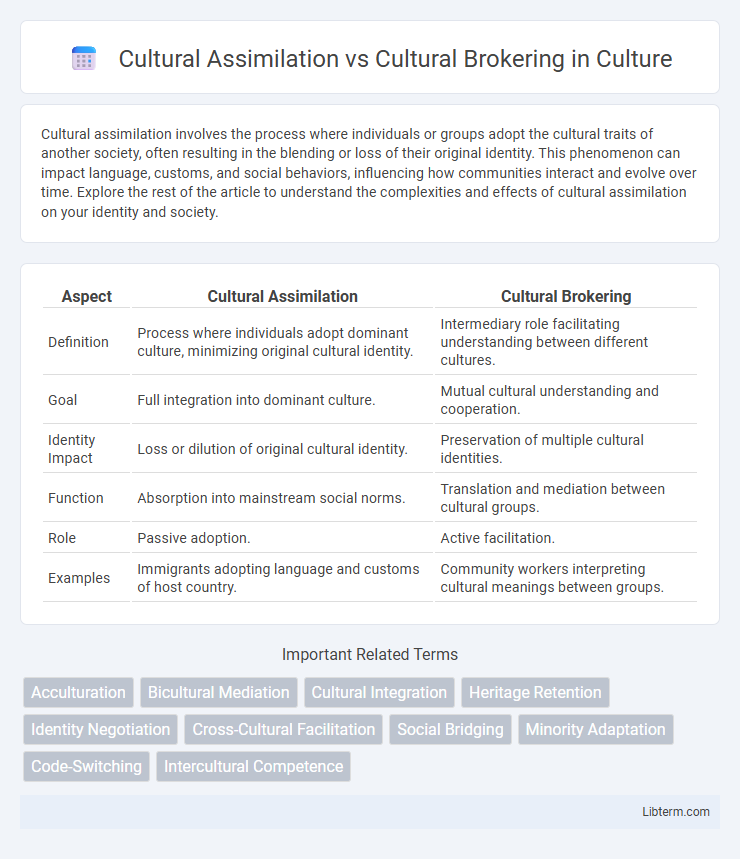Cultural assimilation involves the process where individuals or groups adopt the cultural traits of another society, often resulting in the blending or loss of their original identity. This phenomenon can impact language, customs, and social behaviors, influencing how communities interact and evolve over time. Explore the rest of the article to understand the complexities and effects of cultural assimilation on your identity and society.
Table of Comparison
| Aspect | Cultural Assimilation | Cultural Brokering |
|---|---|---|
| Definition | Process where individuals adopt dominant culture, minimizing original cultural identity. | Intermediary role facilitating understanding between different cultures. |
| Goal | Full integration into dominant culture. | Mutual cultural understanding and cooperation. |
| Identity Impact | Loss or dilution of original cultural identity. | Preservation of multiple cultural identities. |
| Function | Absorption into mainstream social norms. | Translation and mediation between cultural groups. |
| Role | Passive adoption. | Active facilitation. |
| Examples | Immigrants adopting language and customs of host country. | Community workers interpreting cultural meanings between groups. |
Understanding Cultural Assimilation: Definition and Key Concepts
Cultural assimilation involves the process where individuals or groups gradually adopt the cultural traits of another dominant culture, often leading to the loss of their original cultural identity. Key concepts include acculturation, integration, and adaptation, highlighting how social, linguistic, and behavioral changes align with the dominant society's norms. This process can impact various aspects such as language proficiency, social interactions, and value systems within immigrant or minority communities.
Exploring Cultural Brokering: Bridging Divides
Cultural brokering plays a crucial role in bridging divides by facilitating communication and understanding between different cultural groups, often within immigrant and indigenous communities. Unlike cultural assimilation, which encourages adopting the dominant culture, cultural brokering fosters mutual respect and adaptation, enabling individuals to navigate multiple cultural contexts effectively. This approach enhances social cohesion and empowers marginalized groups by validating diverse cultural identities while mediating access to resources and opportunities.
Historical Perspectives on Assimilation and Brokering
Historical perspectives on cultural assimilation emphasize the absorption of minority groups into dominant societies, often resulting in the erosion of original cultural identities through policies like the U.S. Indian Boarding Schools and European colonialism. In contrast, cultural brokering historically involved individuals or groups acting as intermediaries to facilitate understanding and negotiation between cultures, exemplified by Native American interpreters during early American history and colonial trade facilitators. These distinct approaches reflect differing power dynamics: assimilation as enforced conformity versus brokering as strategic mediation fostering cultural exchange.
Core Differences: Assimilation vs. Brokering
Cultural assimilation involves individuals or groups fully adopting the dominant culture's customs, language, and values, often at the expense of their original cultural identity. In contrast, cultural brokering serves as an intermediary role where individuals facilitate understanding and communication between different cultural groups without requiring them to abandon their distinct identities. The core difference lies in assimilation's focus on cultural uniformity versus brokering's emphasis on cultural navigation and respect for diversity.
The Role of Identity in Both Processes
Cultural assimilation involves individuals adapting and often relinquishing their original cultural identity to conform to a dominant culture, which can lead to identity loss or transformation. In contrast, cultural brokering emphasizes maintaining and negotiating multiple cultural identities, facilitating understanding and cooperation between differing cultural groups. The role of identity in these processes is crucial, as assimilation challenges identity preservation while brokering fosters bicultural or multicultural identity integration.
Impacts on Minority Communities
Cultural assimilation often leads to the erosion of minority communities' unique identities, resulting in loss of language, traditions, and social cohesion. In contrast, cultural brokering facilitates mutual understanding and respect by bridging cultural gaps, empowering minority groups to navigate dominant societal systems while preserving their heritage. The impact on minority communities is profound, as cultural brokering supports resilience and inclusion, whereas assimilation may contribute to marginalization and identity dilution.
Benefits and Drawbacks of Cultural Assimilation
Cultural assimilation offers benefits such as easier social integration, improved communication, and access to broader economic opportunities by adopting the dominant culture's norms and values. However, it also risks significant drawbacks including loss of original cultural identity, diminished linguistic diversity, and potential psychological stress due to pressure to conform. Balancing assimilation with cultural preservation remains a complex challenge for individuals and communities navigating multicultural societies.
Advantages of Cultural Brokering in Diverse Societies
Cultural brokering facilitates effective communication and mutual understanding by bridging gaps between diverse cultural groups, fostering social cohesion and reducing conflict. It empowers individuals to retain their cultural identity while navigating different societal norms, enhancing inclusivity and respect. This approach promotes collaborative problem-solving and resource sharing, enriching community dynamics and support networks in multicultural environments.
Real-World Examples of Each Approach
Cultural assimilation often occurs when immigrants adopt the dominant culture's language, customs, and values, as seen in the Americanization of European immigrants in the early 20th century, where many abandoned their native languages to integrate into U.S. society. In contrast, cultural brokering is exemplified by Native American interpreters who mediate between tribal communities and federal authorities, facilitating mutual understanding without erasing indigenous identities. These examples highlight assimilation's emphasis on conformity versus brokering's role in fostering bicultural communication and preservation.
The Future of Cultural Integration: Finding a Balance
Cultural integration advances by balancing cultural assimilation and cultural brokering, enabling diverse communities to maintain heritage while engaging effectively with dominant societies. Innovative policies emphasize mutual respect and adaptive communication strategies, supporting both individual identity and social cohesion. Future cultural frameworks prioritize inclusivity and dynamic exchange, fostering environments where multiculturalism thrives alongside unified national narratives.
Cultural Assimilation Infographic

 libterm.com
libterm.com